Gelsemium sempervirens
Though the profuse bell-shaped, yellow flowers that adorn the lengthy, twisted vines of Carolina jessamine are truly breathtaking, they conceal a deep, dark secret.
They, along with the rest of the plant, are capable of murder.
But no worries – just don’t eat it and you’ll be fine! And you’ll be thrilled with the spectacular show this plant puts on each spring.
Really.
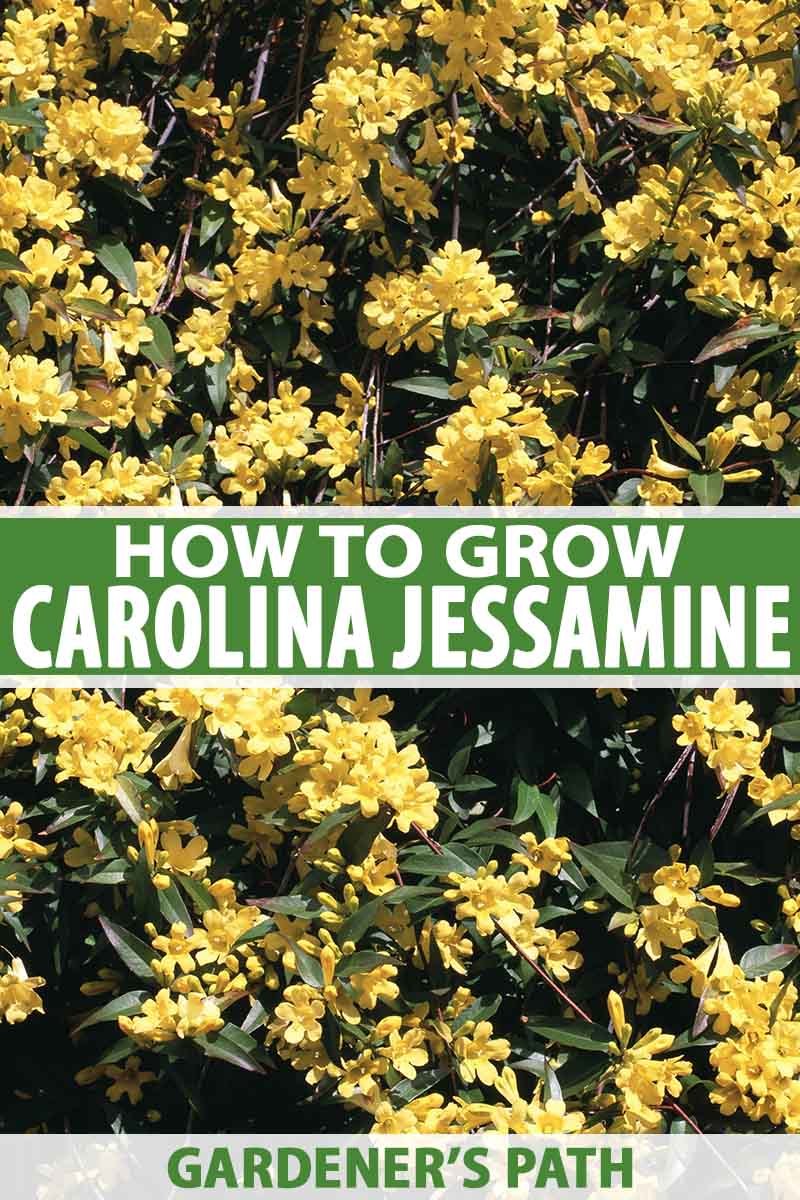
We link to vendors to help you find relevant products. If you buy from one of our links, we may earn a commission.
Don’t let our silly drama scare you off. G. sempervirens is a colorful and beloved vine that is native to the southeastern and south-central United States as well as to Honduras, Guatemala, Belize, and Mexico with nary a homicide to its name.
Even deer are smart enough to leave this one alone, so you needn’t fear for the lives of your neighborhood foragers.
Climbing 10 to 20 feet up and over fences, trellises, walls, and anything else that gets in its way, this evergreen vine – hardy in USDA Hardiness Zones 7 to 9 – is a favorite for the cheerful color and heady perfume of its inch-long blooms borne on wiry reddish-brown stems.
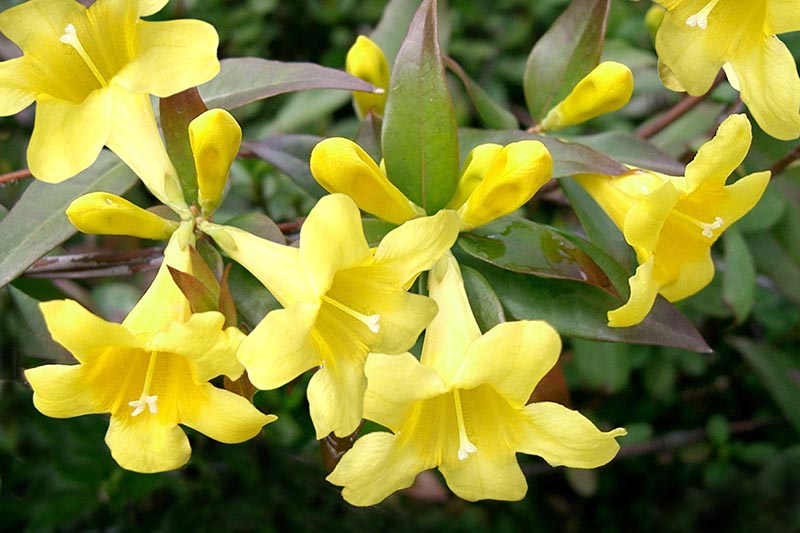
The appearance of its bright flowers is often taken as a sign that winter is coming to an end.
Homicidal tendencies aside, does this beauty sound like it might bring some much-needed drama to your garden? Here’s what you’ll learn in this article:
What You’ll Learn
Of course, every potential murderer has a list of aliases, and this one is no exception.
Yellow jessamine, Carolina wild woodbine, evening trumpet flower, poor man’s rope, and Carolina jasmine are among the known pseudonyms attached to this plant.
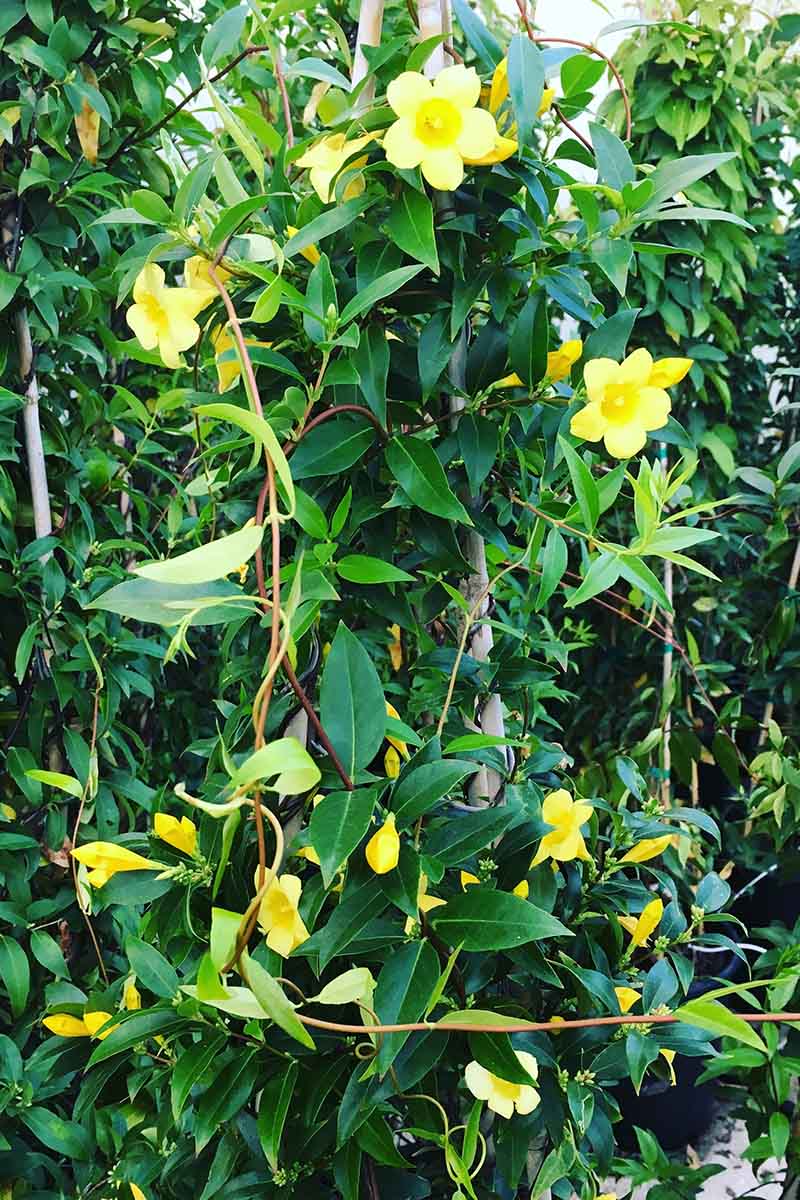
On the scientific side, it might go by Bignonia sempervirens or the misspelled Bigonia sempervirens.
Carl Linnaeus, the Swedish botanist known as the “father of modern taxonomy,” first classified Carolina jessamine as Bignonia sempervirens in 1753.
However, French botanist Antoine Laurent de Jussieu shook things up in 1789 with the publication of “General Plantarum,” wherein he defined groups of plants differently than Linnaeus had.
This included Jussieu reclassifying Carolina jessamine into his newly created Gelsemium genus.
The other two plants in this three-plant genus include the also-poisonous G. rankinii and G. elegans.
Gelsemium was once classified in the family Loganiaceae but was reclassified into Gelsemiaceae in 1994.
In addition to Gelsemium, the Gelsemiaceae family includes two other genera: Mostuea and Pteleocarpa.
Mostuea consists of nine small flowering shrubs. Two, M. brasiliensis and M. muricata, are native to Brazil, while the others, including M. brunonis and M. adamii, are native to tropical Africa.
Just one plant resides in Pteleocarpa: P. lamponga, a medium-sized tree native to southern Thailand, parts of Malaysia, Sumatra, Singapore, Borneo, and Bangka.
Cultivation and History
In Joint Resolution No. 534 passed in 1924, this lovely climber was declared the state flower of South Carolina.
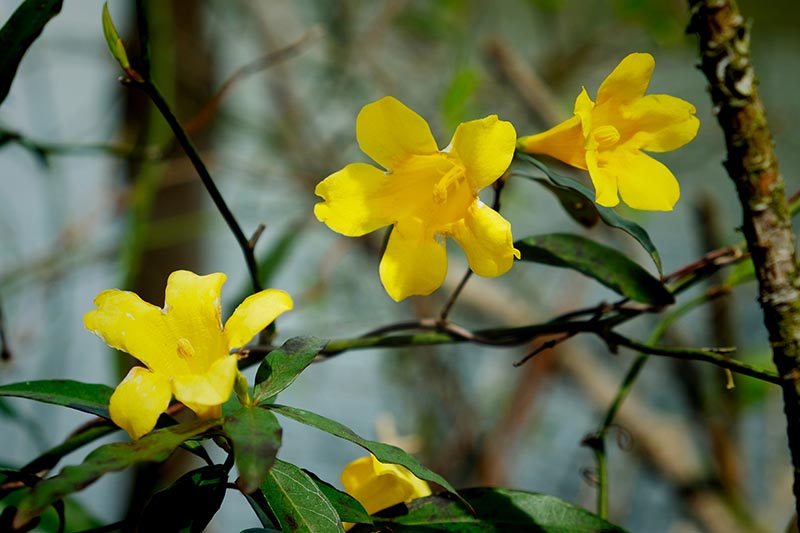
In doing so, the state’s General Assembly said, “It is indigenous to every nook and corner of the State; it is the first premonitor of coming Spring; its fragrance greets us first in the woodland and its delicate flower suggests the pureness of gold; and its perpetual return out of the dead of Winter suggests the lesson of constancy in, loyalty to, and patriotism in the service of the State.”
There you have it: language as flowery as the plant itself.
A 2013 paper by William King, Dr. Leo Pezzementi, Dr. H. Wayne Shew at Birmingham-Southern College in Birmingham, Ala., says that research suggests that the alkaloid chemicals in Carolina jessamine, “when diluted to low enough concentrations, may be effective analgesics (pain relievers), anxiolytics (anxiety reducers), and anti-cancer drugs.”
But more studies are required to confirm the plant’s effectiveness as a medicinal agent, according to the trio.
Propagation
Perhaps unsurprisingly, this cold-blooded killer (just kidding) is quick to reproduce, and is amenable to several methods of propagation.
From Seed
Carolina jessamine is easily started from seed.
If you are collecting seeds, pick pods in the fall after the seeds inside have turned brown. Refrigerate the seeds until you’re ready to use them to keep them fresh and viable.
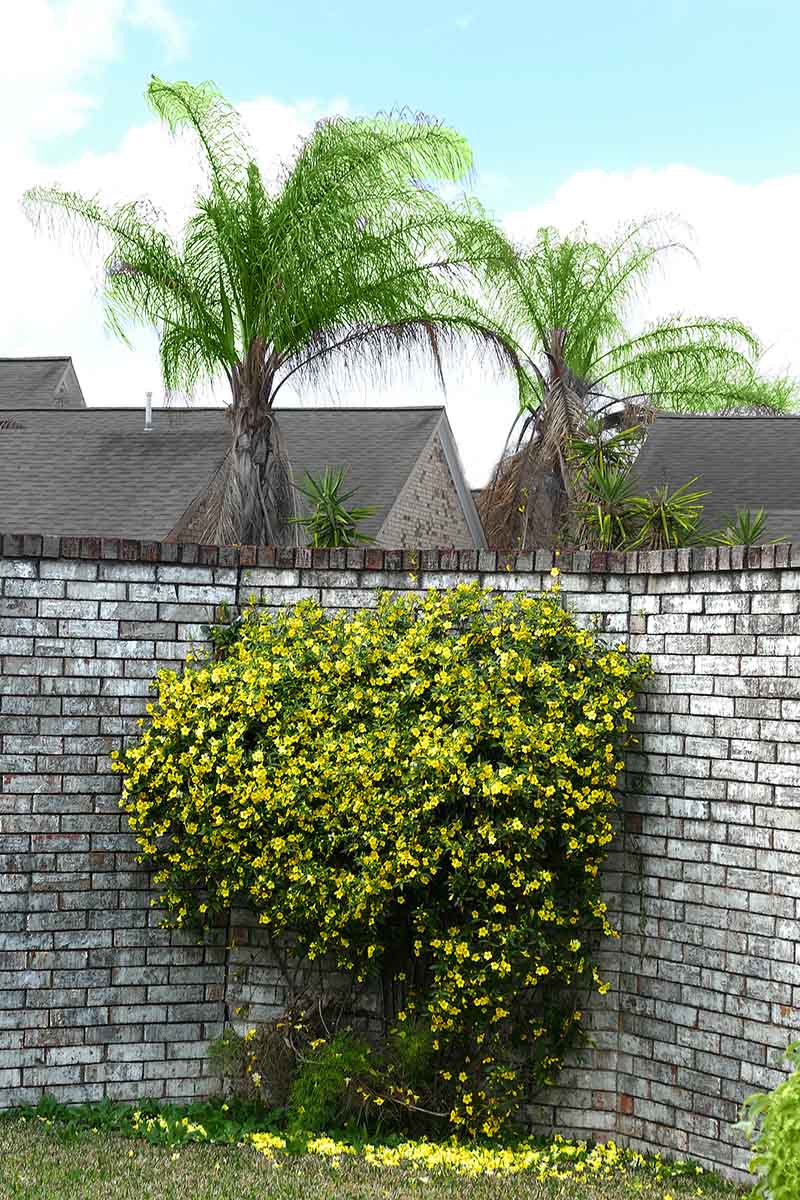
Plant the seeds in a well-draining growing medium, and place the pots or trays indoors, in a place where they receive bright light throughout the day.
Keep the soil moist until the seeds germinate in seven to 10 days, then water twice a week.
If you’ve started your seedlings in the fall, they should be ready to transplant outdoors in the spring, while it’s still cool.
If you start seeds later than fall, you’ll be better off letting them mature in their containers until the next fall before setting them out.
From Cuttings
This plant will root from semi-hardwood cuttings.
Using a clean, sharp implement, cut a four- to six-inch piece of stem late in the growing season when the new year’s growth has matured, in mid- to late summer.
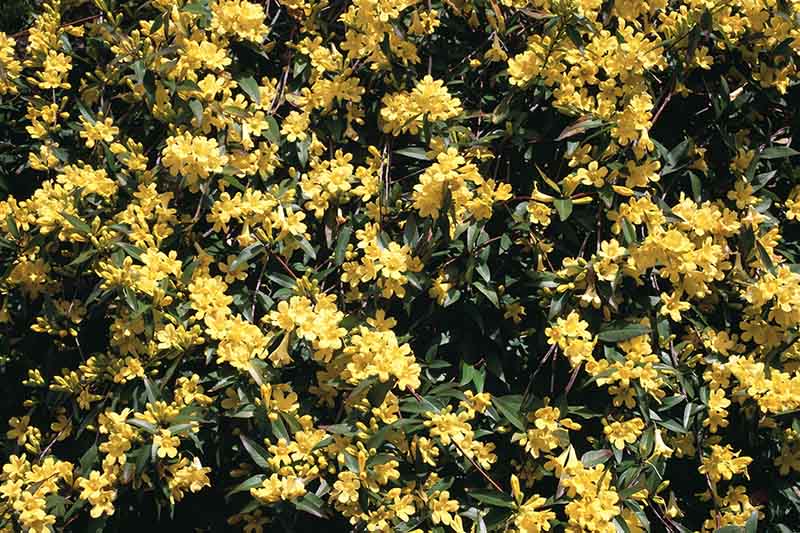
Fill a pot with good drainage with a good-quality growing medium. Insert a pencil into the soil and remove it to create a hole to receive the cutting.
Strip the leaves from the bottom third of your cutting, dip the cutting into powdered rooting hormone, and place the cutting into the hole in the prepared container.
Keep the growing medium evenly moist, in a warm area with indirect light, until the cutting begins to root. This should take about 10 to 12 weeks.
After you see growth, you can reduce waterings a bit. In autumn, feed the plants once a month with one teaspoon of NPK 10-10-10 fertilizer per quart of potting mix. In winter, reduce the quantity of fertilizer to one-half teaspoon.
Keep your new plants in a protected place until early spring, and then transplant outdoors when it’s still cool.
Keep in mind that you may not see newly rooted jessamine cuttings bloom for the first three years.
Division
Another way to get more plants is by dividing the rhizomes. Start by digging up your jessamine in September or October. Remove the excess soil from the rhizomes, and then cut them into pieces, making sure that each rhizome has at least one bud on it.
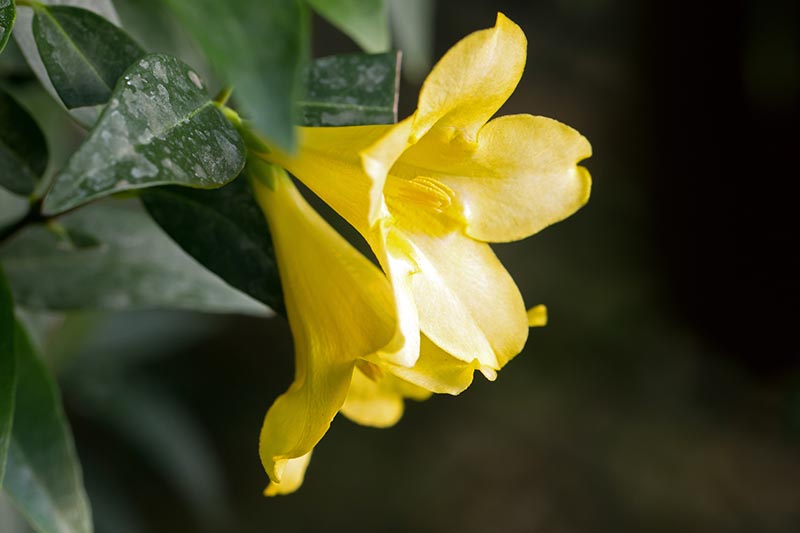
Bury the rhizomes in the ground to about the same depth they were planted when you dug them up, and water well. Continue to water twice a week throughout winter. In spring, you should see some above-ground activity.
From Seedlings and Transplanting
Transplant purchased or homegrown seedlings by simply digging a hole the same size as the container from which you are transplanting, and then placing your new plant in the hole.
You’re best off planting in early spring or fall, when it’s cool.
Water well, and add mulch around the planting area.
Layering
Yet another propagation method takes advantage of jessamine’s willingness to put down roots wherever it comes in contact with soil.
In summertime, simply trail a vine along the ground, burying five-inch segments at regular intervals, leaving eight to 10 inches between buried segments. For even better success, administer a small, slanting cut a quarter of the way through the portions of the stem you intend to bury.
Give your layered length of vine some extra water – twice a week. Once the segments have rooted, cut the mother vine to separate the rooted portions.
Carefully dig up the rooted portions and replant as desired, as described in the seedlings and transplanting section above.
How to Grow Carolina Jessamine Vines
Plant jessamine along a fence or wall, or even as a ground cover. While this plant will tolerate some shade, you’ll find it blooms much more prolifically and grows much more densely in full sun. In the right conditions, it will grow three to five feet per year.
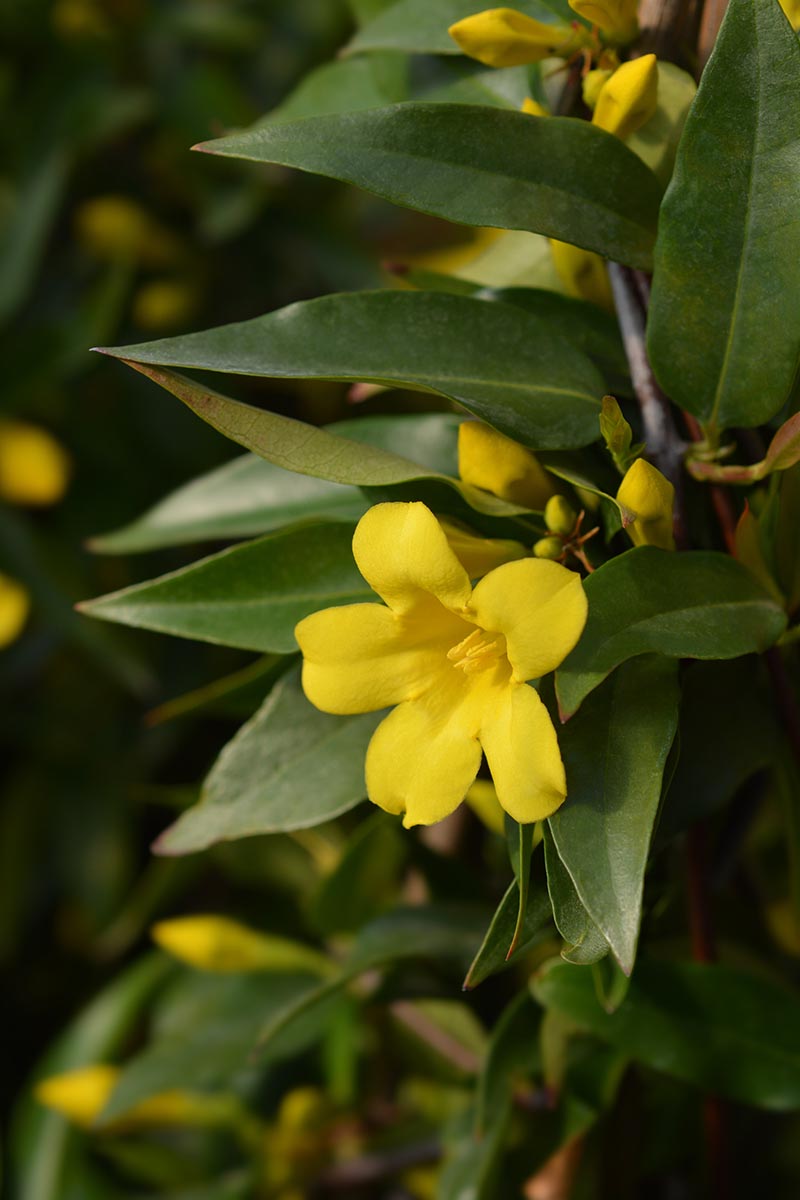
It’s also drought tolerant to an extent, but again will perform much better if watered regularly. And the same can be said for soil. It will survive in poor soil, but is much happier in organically rich soil with a pH of 6.0 to 7.5.
Not sure what type of soil you have? Conduct a soil test to understand whether these plants will do well in your soil, or if you need to amend it.
Many years ago, I planted two jessamines in not-good soil (I was younger and dumber then). One of the plants lasted a few years before succumbing; the other lasted many years but never really did much in terms of producing foliage or grand floral displays.
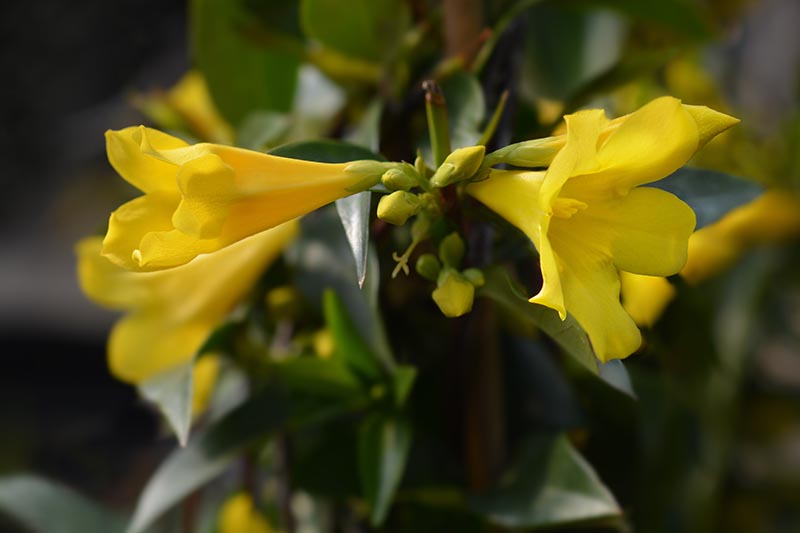
The second one finally bit it this past August when I failed to water it often enough.
Want to see better results than I did the first time around?
Fertilize Carolina jessamine in late spring after the plant flowers. Use a moderate amount of a slow-release balanced fertilizer. Don’t over-fertilize, as this will reduce flowering.
If you’re planting for ground cover, space plants three feet apart; if you’re looking to cover a vertical space, space the plants four to eight feet apart.
Growing Tips
- Provide rich, organic soil and full sun for best results
- Fertilize in late spring
- Water regularly to maintain even moisture
Pruning and Maintenance
Carolina jessamine vines can get leggy and top heavy if not properly pruned once a year.
Bring out the clippers after it blooms in the spring. Clean out the old, dead stems and do some general cleanup, cutting it a bit smaller than the full size you’re aiming for.
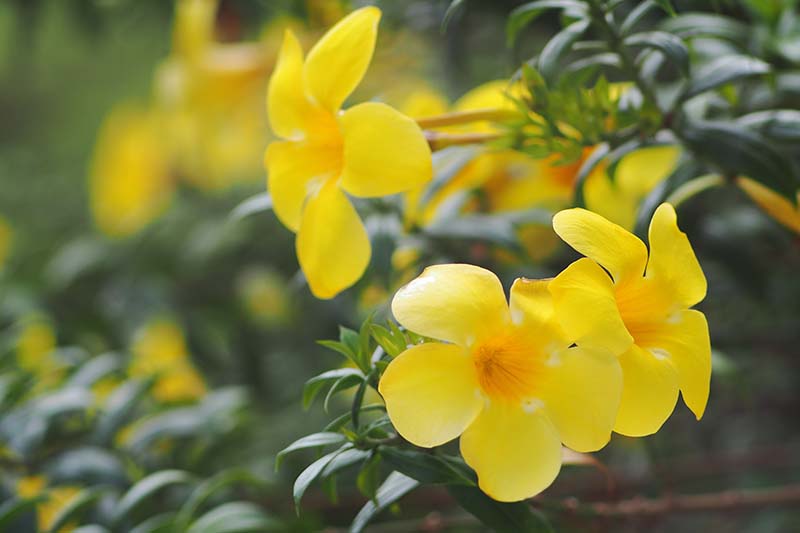
Oh, and be sure to wear gloves and long sleeves for the trimming process, as some people experience contact dermatitis from touching the plant. (See? I bet you’ve been so lulled by its charms so far that you forgot it’s also a bit evil.)
If you’re growing jessamine as a ground cover, keep the vines trimmed to about three feet long, but be sure to do the spring trimming only after the bloom period.
Carolina Jessamine Cultivars to Select
What you’ll likely see scrambling over dilapidated fences and up tombstones in the southeast is the species plant, G. sempervirens.
You can find live plants available in three-gallon containers available from FastGrowingTrees.com.
And, unsurprisingly, breeders have developed a few crafty cultivars that might catch your fancy.
‘Pride of Augusta,’ for example, develops double, ruffled flowers. This type is thought to have been introduced many years ago by the now-defunct Fruitland Nursery in Augusta, Georgia.
‘Margarita’ is a superior seedling discovered by Don Jacobs of Eco Gardens in Decatur, Georgia.
Jacobs was impressed by the selection’s larger, more prominent flowers, and named the variety after his wife. It has been found to be more cold-tolerant – hardy to Zone 5a – than species jessamine.
Managing Pests and Disease
Carolina jessamine has no serious disease or insect problems.
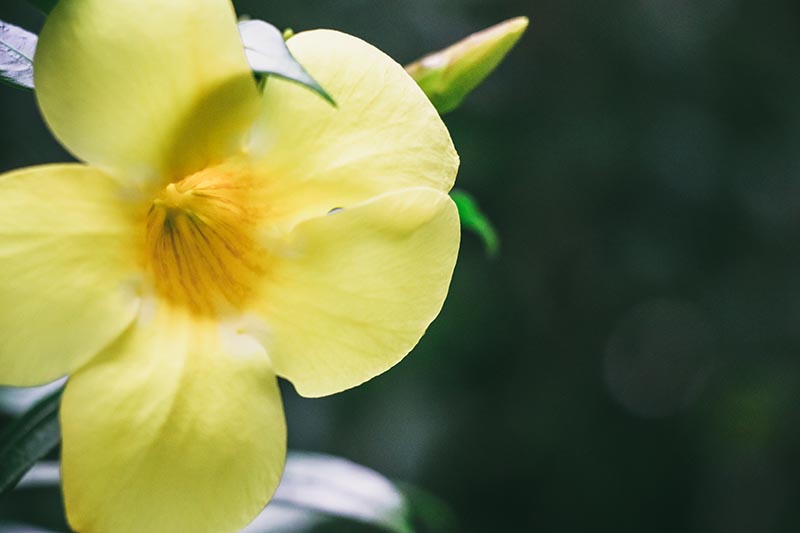
If the leaves stay wet for an extended period, you may see some fungal leaf spotting, which presents as brown, tan, or black spots and can be treated with a fungicide.
You may occasionally see aphids on jessamine.

Aphids are tiny, sap-sucking insects that may be green, red, brown, yellow, or black. They harm plants by sucking essential fluids from leaves and other plant parts.
Use insecticidal soap to kill these pests, or get rid of minor infestations with a strong spray from a garden hose. See our guide to learn more about controlling aphids in your garden.
Best Uses for Carolina Jessamine Vines
Carolina jessamine is lovely when grown on an arbor or trellis.
It also makes an attractive ground cover for areas with little to no foot traffic.
Quick Reference Growing Guide
| Plant Type: | Perennial evergreen vine | Flower / Foliage Color: | Yellow; dark green |
| Native to: | Southeastern and south-central United States, Honduras, Guatemala, Belize, Mexico | Maintenance: | Moderate |
| Hardiness (USDA Zone): | 7-9 | Tolerance: | Drought (but plant won’t flower or fill out as much) |
| Bloom Time / Season: | Early to mid-spring | Water Needs: | Moderate, consistent moisture |
| Exposure: | Full sun, partial shade | Soil Type: | Organically rich |
| Time To Maturity: | 3 years | Soil pH: | 6.0-7.5 |
| Spacing: | Ground cover: 3 feet apart; climbing vine 4-8 feet apart | Soil Drainage: | Well-draining |
| Planting Depth: | Same as transplant container | Companion Planting: | Swamp jessamine |
| Height: | 10-20 feet | Uses: | Structure ornament, ground cover |
| Spread: | 20-30 feet | Family: | Gelsemiaceae |
| Growth Rate: | Fast, once established | Genus: | Gelsemium |
| Attracts: | Butterflies, hummingbirds, other pollinators | Species: | sempervirens |
| Common Pests: | Aphids | Common Disease: | Leaf spot |
Lethal but Lovely
It’s easy to live with this deadly beauty; just don’t eat it. And be sure to warn children against mistaking the attractive blooms for those of honeysuckle.
The spectacular allure provided by these twining vines outweighs the easily avoidable risks associated with growing them.
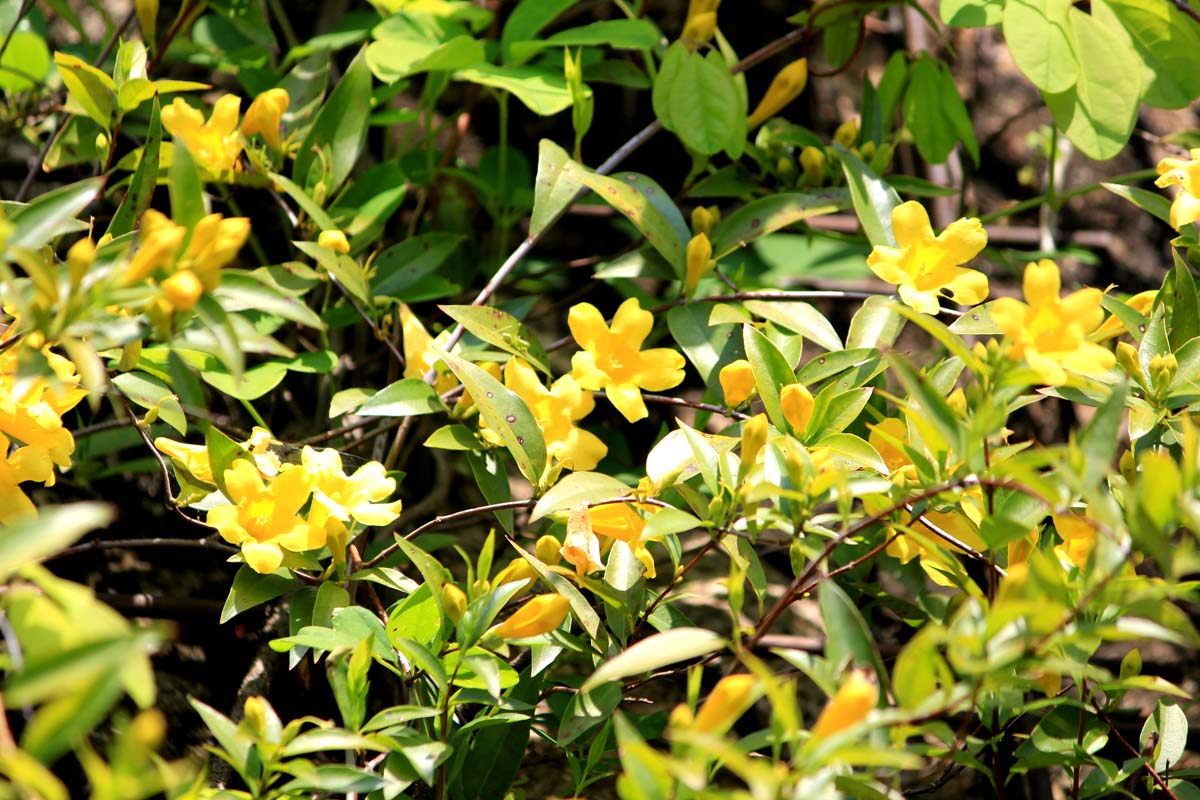
Care is fairly simple for this aggressive climber – all it needs is some sun, even moisture, an annual haircut, and maybe a dose of fertilizer once a year.
Have you grown Carolina jessamine? Any tips to share? Add your two cents in the comments section below.
Looking for more vines to adorn your garden? Check out these articles next:

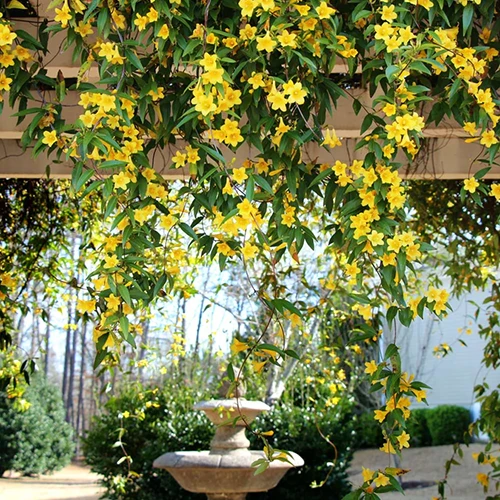
I’ve planted Carolina jessamine to climb a trellis over my sunny front door, and it has been spectacular for a couple of years. But persistent problems with brown spot (also red spider mites) have caused it to lose most of its leaves and flowers and I have finally given up on it. I need something that will require less TLC.
Hello Bernard Fagan. Any interest in trying another twiner, Chocolate vine (Akebia quinata)? It’s not as showy as Carolina jessamine, but it has attractive leaves like a schefflera house plant and the understated blooms smell heavenly. It is hardy in USDA zones 4 to 8, and, most importantly for you, it doesn’t have trouble with insects. Good luck in finding something. Brown spot is a bummer.
In Sugarland, TX. I also have five Carolina jessamine plants that did very well for the first seven months, but in the past two months they have become covered with what appears to be Black Spot. Many sites suggest removing the damaged area. In my case ALL leaves are covered.
Will a fungicide help? If so, what type? I think I am the worst gardener ever!!!!!!
First of all- you’re not the worst gardener, Richard! Troubleshooting is part of the process, and every gardener encounters disease issues in their plants at some point – but not every gardener seeks out help when they need it, and I commend you for that. Have you received a lot of rain lately? Unfortunately, fungal pathogens can thrive in high humidity, and water that sits on the foliage without drying quickly can invite disease. Black spots can also be a sign of bacterial infection. And sooty mold, a different fungal infection, is exactly what it sounds like – a dark,… Read more »
Hi Gretchen! Is this vine safe for hummingbirds to drink from? I want to add them along my back wall specifically for my hummingbird friends. We also have bunnies so I’m hoping they don’t eat it. Thanks so much for your advice! 🙂
Hello Autumn! According to the Audubon Society, Carolina jessamine is a suitable nectar source for hummingbirds, though it also said ruby-throats tend to avoid this particular ornamental in the Southeast. Maybe they know something we don’t?
As for the bunnies, once it gets some height, it should be fine. But consider a short fence while the vines are getting established. Good luck, and keep us posted on what you decide.
Hello all,
I just bought a place outside of Del Rio Texas on the Rio Grande River and am sure glad to of found this site as it helped me to determine exactly what vine I have growing. There is a wealth of knowledge in your post about the Carolina Jessamine vines and I love it. Looking forward to starting sum cuttings after the blooming finishes.
Thank you
Capt Dan
Good luck with your cuttings Capt Dan! Let us know how you get on. Thank you for your kind words!
Love your article. The property manager had the vine that had been growing here long before I got here cut down after asking if I wanted to keep it.
It is coming back and I am making an arbor away from the building.
The vine was so beautiful in February growing along the carport…sigh.
Aw, Lee Anne. It’s so hard to bear when other folks ruin fabulous ornamental vines. Glad to hear you’re plotting the comeback. Hoping it’s just as beautiful!
Does the Caroline Jessamine have an aggressive root system? I would like to plant a few to climb a trellis, but was wondering if I should plant them in a container. My husband worries that the roots will damage our tar-and-chip flooring in our carport.
Hello Traci B! The Carolina Jessamine spreads aggressively, but the roots aren’t so strong as to tear up flooring. I get what your husband is thinking, though–there are certainly ornamental vines that could damage property in that way! It is an option to grow it in a container. If you take that route, make sure to provide ample support. My only caution would be not to plant it near a footpath or somewhere kids play since it is toxic if consumed. But if that’s not an issue, I think your plan is sound, whether you plant it in the ground… Read more »
I wanted to find out how Carolina jessamine does in the direct southwest summer sun zone 9 Las Vegas NV
This plant can withstand moderate drought and full sun conditions in hot and dry climates like yours, but it will need to be irrigated regularly to perform well. Plants that are not yet established in particular may benefit from some shade protection to get through the hottest periods of the summer.
Hi. I’m trying to grow Carolina jessamine indoors in my office. I mounted a trellis on my wall. Well drained soil. My plant is growing but at a very slow rate. Can someone tell me if this is a viable approach considering ~3-4 hours of direct sun and ~6+ hours of indirect sun?
Hello Amir, I am intrigued by your attempt to grow Carolina jessamine indoors. I think it will work okay, though there’s a danger it will lose its leaves (or most of them) if it is too dry in your office or the plant doesn’t get enough water. That amount of light will also probably be okay to keep it growing, though you could always look into a grow light if it seems like it’s having trouble. I also wanted to let you know that the plants do grow more slowly the first year or even two years, though, of course,… Read more »
Hello; I am planning to plant Red Virginia Creeper at the side of my house. Will Carolina Jessamine work well with the Virginia Creeper and what does the Carolina Jessamine look like during its non-blooming (dormant) phases?
Hello Fran. While the colors would look lovely together, you’d need lots of room to grow these two close to each other. They both grow in full sun to part shade, and they require the same type of soil. But the difficulty is space. Unless your sideyard is massive, the two might compete. Virginia creeper is invasive and can grow and spread 50 feet! Carolina jessamine doesn’t take up as much space, growing to 15-120 feet tall at maturity, but it would need isolated space or the creeper might choke it out. I’d recommend choosing one or the other… If… Read more »
We are building a very long pergola tunnel in our yard, 10 feet away from the house next to a fence. Would it work to plant Carolina, pink and star jasmine to grow together on this very long pergola. I love that they are all evergreen and have alternating bloom times. I’ve grown star and pink jasmine before but never Carolina jasmine. Here’s a pic of the area we are planning to build. As you can see it’s very long. Love to hear your advice. Thank you, pam
Hello Pam delgadillo. Wow, that’s a gorgeous space that looks like a splendid area for some vining flowers. I’m assuming since you’ve grown the jasmines before you live in a Zone where all three varieties are hardy, 7-11 for the jasmine, 8-10 for the star jasmine, and 7-9 for the Carolina jessamine. As for intermingling them for successive blooms, the only issue could be the star jasmine. It requires a slightly more acidic pH than the other two: 5.5-6.5 versus 6.0-7.5 for the Carolina jessamine and jasmine. And of course, you’ll want to space them properly so none of the… Read more »
Hey Gretchen ,
Got to the end of this article and I see you. Thinking of planting Carolina Jessamine again. Remember the one I had on Rae Dell? It liked that sunny spot in front of the house.